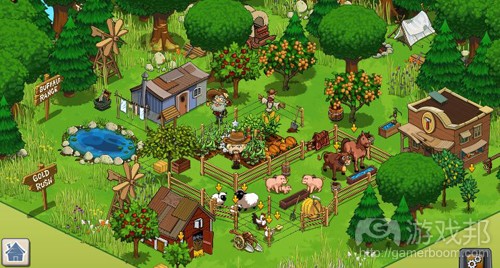点评社交游戏在2011年5大发展趋势
作者:Jared Lorince
在过去几年里,社交游戏市场发生了巨大的变化。以下是我根据Steve Meretzky和Playdom成员Dave Rohrl的对话总结的2011年社交游戏5大发展趋势:
趋势1:挖掘并扩展游戏题材。Zynga的《FrontierVille》(后改版为《Pioneer Trail》)的发行被当作Facebook游戏的一大分水岭,它打破了2009至2010年间该平台上农场游戏的主导地位。《FrontierVille》的出现拓宽了Facebook游戏市场,它将基本的农场游戏机制整合进一种更深层次且更复杂的游戏中,而这类型游戏往往具有较为完整的故事情节和丰富的功能设置。可以说《FrontierVille》提升了Facebook游戏的“档次”,而其它开发商也紧随Zynga的脚步,相继推出许多该类型的游戏,不亚于《FarmVille》所带来的潮流。
趋势2:高质量游戏的时代。如今社交游戏的质量越来越高了。社交游戏市场的现状是,因为开发者能够更加方便地调整并完善那些已经发行的游戏,促使游戏开发周期大大缩短了,而开发者也更倾向于推出一些较小的游戏,但是关于“小游戏”的定义标准却发生了变化。这并不是说人们已经彻底抛弃“极简主义”,只是日益饱和的游戏市场改变了“小游戏”的定义。如今的市场充斥着越来越多社交游戏,迫使开发者们不得不使出浑身解数凸显自己的游戏,包括增加产品价值,添加一些新功能,并不断完善及调整自己的游戏。
趋势3:休闲游戏的盛行。自从PopCap在2011年发行了休闲游戏《宝石迷阵闪电战》,这股热潮便开始慢慢涌现在整个游戏市场中。有效的用户获取途径(通过Facebook等平台),大受欢迎的游戏设置以及玩家熟悉度(现在很多Facebook用户都玩这些游戏好多年了)等结合在一起便是推动休闲游戏大受欢迎的重要原因。
趋势4:休闲竞争游戏。早前大多数Facebook游戏中只有一些简单的竞争机制(主要是基于排行榜),而主要的社交成分还是好友间的相互协作。但是近来,如《Army Attack》和《Empires & Allies》等一些游戏的成功证明了一个事实,即玩家喜欢相互竞争,并且愿意为了战胜对方而花钱。所以今后,我们必将能够看到越来越多优秀的竞争游戏。
趋势5:品牌游戏的兴起。当社交游戏已经取得巨大发展之时,越来越多公司希望能够融入这股潮流,比如《模拟人生》和《Madden Football》都先后进驻了Facebook平台,还有一些非游戏品牌如马自达以及体育电视网ESPN(也推出了Facebook游戏。但是并非单凭品牌就能够保证这些游戏的成功,即使踏进了社交游戏门槛,没有优秀的游戏设计也很难吸引玩家的注意,不过越来越多品牌游戏的出现好证实了社交游戏市场正快速发展。
这五大趋势是我认为最有价值,且最能够突出社交游戏市场发展前景的内容。我们必须清楚地认识到,社交游戏刚刚走出“幼年期”,而2011年只能算是这类型游戏快速增长的成长期。它们获得了越来越多玩家和开发者的关注,并最终将会衍生出越来越多优秀且富有创造性的社交游戏,这种趋势有望进一步缩小休闲与硬核游戏之间的鸿沟。
游戏邦注:原文发表于2011年10月12日,所涉事件和数据均以当时为准。(本文为游戏邦/gamerboom.com编译,拒绝任何不保留版权的转载,如需转载请联系:游戏邦)
GDC Online – Playdom presents: The Year in Social Games
by Jared Lorince
This talk by Steve Meretzky and Dave Rohrl of Playdom was a doozy (and I mean that in the best way possible), reviewing the major changes in social gaming market over the past year. I’m going to use this post to highlight some of the most important trends discussed during the talk, but let me begin with a spoiler: Social games just might have started to grow up. That may be surprising to hear from me, but read on and see if you agree with me (and keep in mind my claim is a modest one).
On to the trends:
Trend #1: Everything must be a frontier. The release of Zynga’s Frontierville (since renamed to Pioneer Trail) was something of a watershed for Facebook games (I’m going to use “social games” and “Facebook games” interchangeably for the purposes of this post, which really shouldn’t be a problem), disrupting the 2009-2010 “year of the farm”, so called due to the overwhelming popularity of Farmiville and its many clones during this period. Frontierville pushed the boundaries of the Facebook game market (which is not to say that they were or are all that expansive, but still) by integrating the basic farming mechanic into a deeper, more complex game with a more developed story and richer feature set. Frontierville pushed the bar higher for Facebook games, and other developers have followed Zynga’s lead, though thankfully without with less of the blatant carbon-copying that we saw last year.
Trend #2: The age of high quality. This segues nicely into our second trend, which is one of social games simply being of higher quality. The status quo in the social game market, thanks largely to the fact that it’s relatively easy to modify and improve these games post-release, has been to push a rapid development cycle and release fairly minimal products, but standards are changing. It’s not so much that minimalism has been pushed aside, but rather that the continuing saturation of the market changed the definition of “minimal”. As the market becomes more and more flooded with social games, developers are forced to distinguish themselves by increasing production values, adding to their feature sets, and releasing games that are all in all more polished.
Trend #3: The casual invasion. Since casual gaming was effectively launched by PopCap games back in 2001 with the release of Bejeweled, the market has been gaining steam, and has become a force to be reckoned with. Why? Improvements in user acquisition (via Facebook and the like), gameplay that has proven popular and engaging, and player familiarity (many Facebook users have been playing these games for a couple years now) all combine to make the casual gaming demographic a lucrative one. The game development community is getting serious about games that are anything but.
Trend #4: Casual competitive gaming. Most early Facebook games had only the simplest of competitive mechanisms (leaderboards, basically), and in general the social component has been largely cooperative. But more recently, the success of games like Army Attack and Empires & Allies has borne out a rather basic truth: Gamers like to fight each other, and they’re willing to pay money to be more effective in that pursuit. In the words of the presenters, competitive games like these are “whale breeding grounds”.
Trend #5: The rise of branding. As social gaming really takes off, more and more companies want to get their foot in the door, and thus we have core gameplay franchises like The Sims and Madden football enter the Facebook foray, as well as offerings from non-gaming brands like Mazda and ESPN. Now, the success of branded games like these is far from guaranteed, – the branding gets them in the door, but good design is still needed to keep them playing – but their prominence testifies to rising popularity of social gaming market.
I’ve only outlined a subset of the trends discussed in the talk, but these were in my eyes the most noteworthy, and are enough to highlight what I see as a glimmer of hope for the social gaming market. I admit I’m critical of games from the likes of Zynga, but I need to be fair and also admit that I more closely identify with the serious, “hardcore” demographic (or at least I did back when I actually had time to play games…). That aside, let us remember that these games are only now coming out of their infancy (Damion Schubert has some interesting thoughts on this, so make sure to check out my interview with him, to be posted soon.), this year seems to represent a time of serious growth for social games. They’re getting more attention from both players and developers, and are finally being pushed to be more innovative and polished. Here’s hoping that it’s acontinuing trend that will help bridge the casual-hardcore gaming divide.(source:motivateplay)








































 闽公网安备35020302001549号
闽公网安备35020302001549号